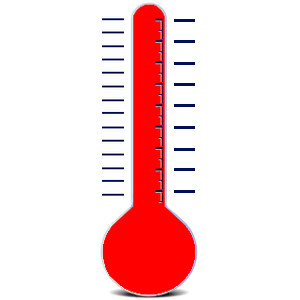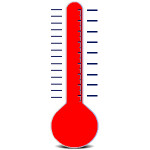by Pathways Magazine – ICPA.org:
Hippocrates taught that fever is the helpful response of the body to the disease process—the body’s way of overcoming disease. About 150 years ago, this theory was replaced by the still prevalent opinion that fever itself is a disease and needs to be treated as such. The tendency today is to give antibiotics, or at least aspirin or acetaminophen, at the first sign of fever. However, recent studies show a strong connection between taking aspirin for viral illnesses, such as chickenpox or influenza, and the subsequent development of Reye’s syndrome. As a result, the Centers for Disease Control and the Committee on Infectious Diseases of the American Academy of Pediatrics now warn against giving aspirin to children. The approved choice, acetaminophen, as well as antibiotics, work to suppress fever “safely.” But when a fever is artificially suppressed in this way, the body’s defense system remains inactive.
Fever needs to be monitored, not suppressed. This allows the fever to mobilize the body’s immune system, which helps fight the disease at hand and is of possible long-range value in a world with immune-deficiency diseases. Monitoring the course of a fever is also a valuable diagnostic tool. Because certain illnesses have characteristic fever patterns, observing your child’s fever will help in a diagnosis. If your doctor advises bringing down the fever or you decide to do so, consider using some of the nonsuppressant therapies discussed later in this article.
Treating Febrile Seizures
What if the fever gets “too high”? When fever runs high, it can sometimes lead to a febrile seizure, or convulsion. Dr. Alvin N. Eden, whose point of view is representative of sound mainstream medical thinking, explains that a “simple febrile seizure” is a convulsion caused by a high fever from an infection anywhere in the body that does not primarily involve the brain. He notes, “Therefore, by definition, a child who has a fever during a seizure does not have epilepsy. Furthermore, simple febrile seizures do not lead to mental retardation.” He suggests that if a child has a febrile seizure, the parents consult with the physician to make sure the child does not have a “complex febrile seizure” which stems from infection in the brain.
What usually happens is that a healthy one or two year old becomes ill, often with a sore throat or ear infection, and starts to run a high fever. If the temperature reaches the child’s particular threshold for convulsions, it produces a seizure. The child may start to twitch and then shake violently all over. He or she loses consciousness, the eyes roll back, and often the child foams from the mouth. “These generalized convulsions, called simple febrile convulsions, rarely last longer than five minutes and stop by themselves without specific treatment. After it is over, the child frequently goes to sleep, and when he wakes up, he is fine. The first seizure is always a harrowing experience for parents, but no permanent damage results, and the baby will be fine.” In almost all cases, the convulsion occurs during the first day of the child’s illness and does not recur during the same illness.
It is important to know what the child’s temperature is at the time of a convulsion, for this is the “threshold convulsion temperature”—the temperature that you want to avoid in future illnesses! One child might have a convulsion at 103°F, while another might be fine until 106°F. The great majority of infants and children never have a febrile seizure.
If your child does have a febrile convulsion, Dr. Eden advises keeping calm, putting the child on his or her stomach, turning the head to one side, and making sure the mouth is empty. Once the seizure is over, you will want to start bringing down the temperature by giving the child a “sponge bath” with lukewarm water or by putting the child into a cool bath. The evaporation of the water causes the body to cool; however, if the water is too cold, shivering may occur, which increases muscular activity and raises the temperature.
Dr. Eden then suggests having the illness diagnosed. He warns that “some doctors recommend that a child who has had a simple febrile seizure should be kept on daily doses of Phenobarbital for a period of two seizure-free years to help prevent any further trouble. If the child is under three years of age at the onset, these doctors recommend that Phenobarbital should be given until he is five years old. Most physicians do not agree with this approach, however.”
If your physician advises Phenobarbital for fever convulsions, seek a second opinion and research the matter yourself, rather than accepting a course of action on which even conventional physicians do not agree. My own experience with young children on Phenobarbital suggests that the drug’s effect is almost like a veil, keeping children from really being “present” in their bodies. As always, the decision and responsibility for your child rest with you. So, become informed of your options and the potential results of various courses of action.
Drawing Out the Fever
Several techniques are available that do not suppress fever but rather draw heat from the body. To help keep a fever from becoming too high, doctors recommend giving the child plenty of fluids (such as water, tea, or juice), keeping the child’s room relatively cool, and giving a sponge bath as mentioned above. Alcohol should not be used in a sponge bath for babies, because it is absorbed through the skin and can cause neurological damage.
A lemon wrap. This technique, described in the useful book, Caring for the Sick at Home, is designed to draw heat away from the head and out the feet. It should be used only if the feet are very hot. Gather long strips of cotton cloth for wrapping the legs. Then, cut a lemon in half and place it in a bowl of warm water. Reach into the water to make slits in the lemon, and then squeeze it by pressing it against the bottom of the bowl. Roll up the cotton strips and soak them in the lemon water.
Now, place a towel under each of your child’s legs. Remove one of the strips from the water, squeeze hard, and begin wrapping the first leg starting at the foot and wrapping from the inside of the arch to the outside of the foot. Continue with additional wraps working all the way up to just above the knee. Be sure to cover the entire foot and leg, without leaving any gaps. Immediately wrap the towel up around the foot and leg to prevent too-rapid chilling. (If you do not have a towel handy, wrap a wool shawl or strips of wool fabric over the wet cotton strips.)
Repeat the entire process on the second leg, working carefully but quickly. Immediately replace the covers. Leave the wraps on until the cotton strips dry. This may take about 20 to 25 minutes. If the fever is still high after half an hour, repeat the procedure.
In the absence of the materials described above, others will do. If cotton strips are unavailable when your child produces a high fever, you can substitute a pair of adult cotton tube socks or a pair of your own knee socks that can reach well up your child’s legs. In lieu of towels, simply cover your child’s wrapped legs and feet with a blanket to prevent too rapid cooling. If you do not have a fresh lemon, try adding vinegar to the water instead.
Article originally posted at ICPA.org.
